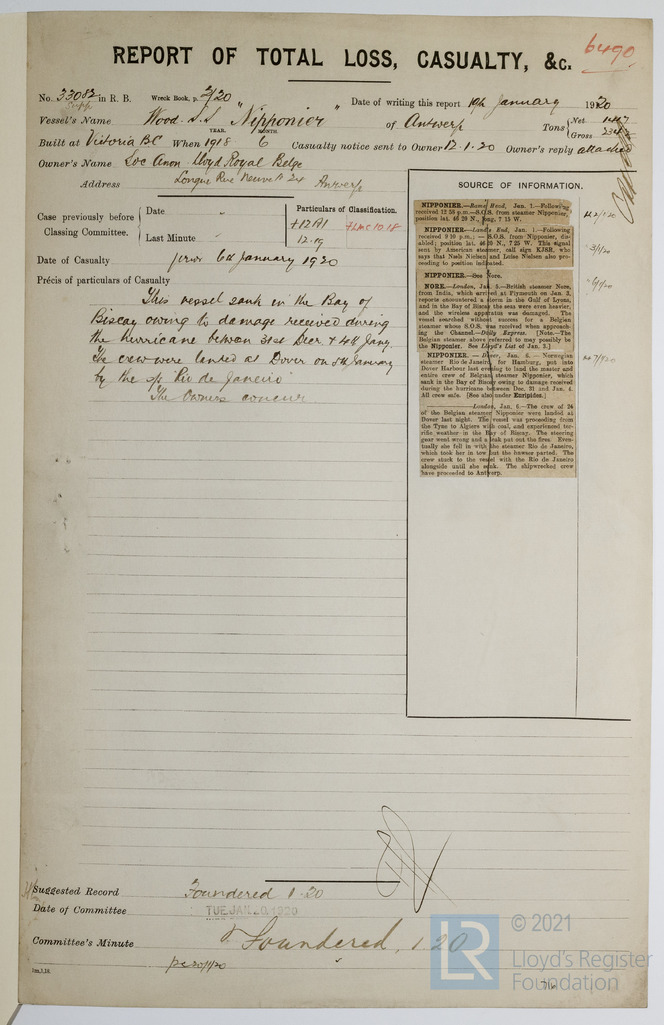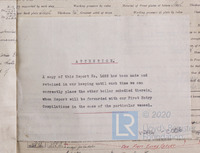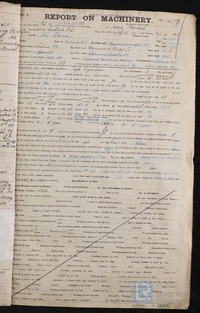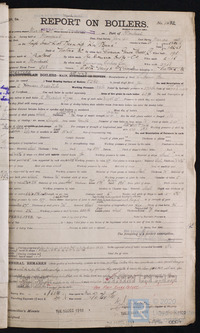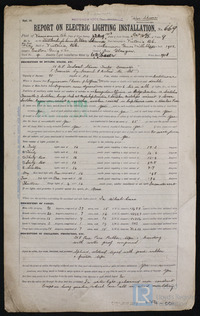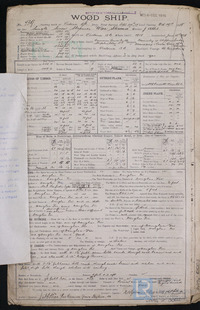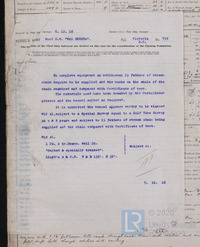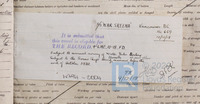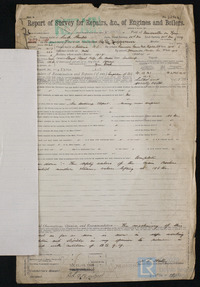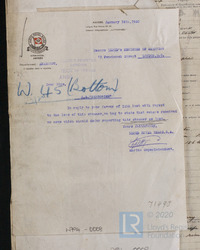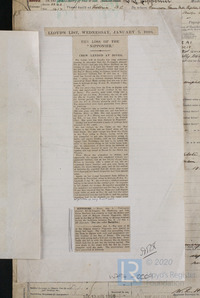- Related documents Related
- Full details Details
- Report document? Report?
Use the data export button to extract customised data sets from the Ship Plan and Survey Report Collection. Available in TSV and CSV formats.
Date recorded as the time of writing.
19/01/1920
The year in which a vessel’s construction is completed.
1918
The individual and/or organisation listed as having been responsible for constructing the vessel. This can/may be the same as the owner and/or manager.
Cameron Genoa Mills Shipbuilders Ltd
The country in which the vessel’s construction took place, at the time of writing.
Canada
Official administrative title (often printed) of a record used by Lloyd’s Register or external organisations.
Report of Total Loss, Casualty, &c./ Wreck reports
The individual and/or organisation listed
Soc Anon Lloyd Royal Belge
The name of the port/place from which a vessel’s voyage originated.
Tyne River
The name of the port/place of destination given.
Algiers
A vessel’s means of propulsion.
Steam
A ship’s total internal volume in ‘register tons’ (replaced by gross tonnage post 1982).
2342
Tonnage derived by deducting from the gross register tonnage the capacity that in unavailable for cargo, e.g. machinery space, fuel, crew accommodation etc.
1417
Is machinery fitted at the aft of the vessel?
No
Generally a smaller additional auxiliary boiler (often used while the vessel is at port).
No
Name of the Proving House responsible for the public testing and certification of a vessel’s anchors and/or chain cables.
No
Contextual information related to the reasons of the vessel’s loss or disposal.
Sank in the Bay of Biscay owing to damage received during a hurricane between 31 December 1919 and 4 January 1920. Steering gear malfunctioned and a leak extinguished the fire in the boilers. All crew were picked up and safely brought to Dover
Recorded information relating the specific cargo being conveyed.
coal
Also referred to as extreme breadth. The distance from the extreme starboard side to the extreme port side.
43.4
Physical extent of a record.
1
Name of ship as recorded on the record
War Skeena
The process of transferring a vessel to water, but not necessarily her completion.
12/06/1918
The port or place in which the vessel’s construction took place, at the time of writing.
Victoria British Columbia
Unique internal numbers used for identifying, referring and retrieving a specific survey report.
6490
Records that constitute Lloyd’s Register’s first official encounters with a specific vessel, e.g. a survey report.
N
Classification symbol assigned to a vessel by Lloyd’s Register’s Classing Committee denoting the quality of construction and maintenance.
+12A1 12.19; in red; +LMC 10.18
Recorded information related to a vessel’s movements.
Gulf of Lyons; Gulf of Biscay
Broad categories and subdivisions of vessels related to their purpose or function.
undefined
Is the steamer assisted by sail?
No
A ship’s total internal capacity of a ship measured in register tons from the top of the floors to the tonnage deck.
1764
Confirmation as to whether the vessel was equipped with refrigeration machinery to aid in the transport of frozen or chilled cargo/goods.
No
Does the vessel possess an auxiliary power source?
No
Is electric lighting fitted to the vessel?
No
The official record pronounced by the Committee
Foundered
Recorded date for the vessel’s loss or disposal.
06/01/1920
Prescribed by flag/registration authorities, and usually excludes a small part of the stern. It is measured from the foreside of the stern at the extreme top to the afterside of the stern post.
249.8
Measurement from the underside of the upper deck on the centre line to the upper side of the bottom plating.
23
Pertinent, useful or interesting recorded content.
Mentions the following vessels "Niels Nielsen"; "Luise Nielsen"; British steamer "Nore" from India; Norwegian steamer "Rio de Janeiro" for Hamburg. British steamer Nore states that her wireless apparatus was damaged in the hurricane
Report an issue with this document
Have you noticed missing or incorrect data or images for this document?
Please let us know and we will rectify the issue as soon as possible.

